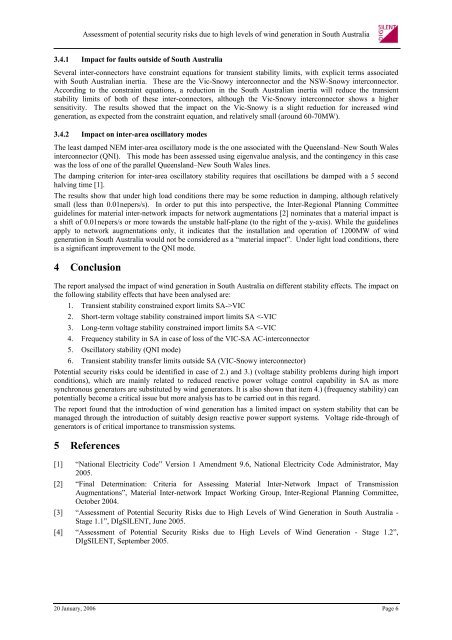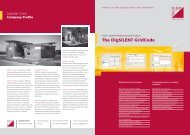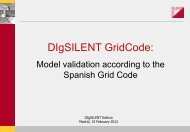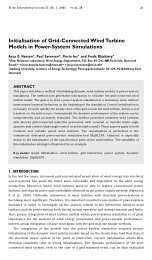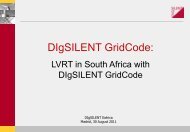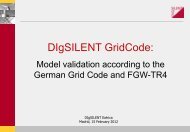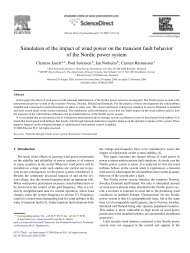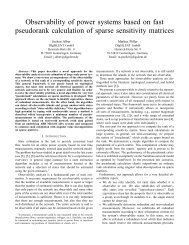Assessment of Potential Security Risks due to High ... - DIgSILENT
Assessment of Potential Security Risks due to High ... - DIgSILENT
Assessment of Potential Security Risks due to High ... - DIgSILENT
You also want an ePaper? Increase the reach of your titles
YUMPU automatically turns print PDFs into web optimized ePapers that Google loves.
<strong>Assessment</strong> <strong>of</strong> potential security risks <strong>due</strong> <strong>to</strong> high levels <strong>of</strong> wind generation in South Australia<br />
3.4.1 Impact for faults outside <strong>of</strong> South Australia<br />
Several inter-connec<strong>to</strong>rs have constraint equations for transient stability limits, with explicit terms associated<br />
with South Australian inertia. These are the Vic-Snowy interconnec<strong>to</strong>r and the NSW-Snowy interconnec<strong>to</strong>r.<br />
According <strong>to</strong> the constraint equations, a reduction in the South Australian inertia will reduce the transient<br />
stability limits <strong>of</strong> both <strong>of</strong> these inter-connec<strong>to</strong>rs, although the Vic-Snowy interconnec<strong>to</strong>r shows a higher<br />
sensitivity. The results showed that the impact on the Vic-Snowy is a slight reduction for increased wind<br />
generation, as expected from the constraint equation, and relatively small (around 60-70MW).<br />
3.4.2 Impact on inter-area oscilla<strong>to</strong>ry modes<br />
The least damped NEM inter-area oscilla<strong>to</strong>ry mode is the one associated with the Queensland–New South Wales<br />
interconnec<strong>to</strong>r (QNI). This mode has been assessed using eigenvalue analysis, and the contingency in this case<br />
was the loss <strong>of</strong> one <strong>of</strong> the parallel Queensland–New South Wales lines.<br />
The damping criterion for inter-area oscilla<strong>to</strong>ry stability requires that oscillations be damped with a 5 second<br />
halving time [1].<br />
The results show that under high load conditions there may be some reduction in damping, although relatively<br />
small (less than 0.01nepers/s). In order <strong>to</strong> put this in<strong>to</strong> perspective, the Inter-Regional Planning Committee<br />
guidelines for material inter-network impacts for network augmentations [2] nominates that a material impact is<br />
a shift <strong>of</strong> 0.01nepers/s or more <strong>to</strong>wards the unstable half-plane (<strong>to</strong> the right <strong>of</strong> the y-axis). While the guidelines<br />
apply <strong>to</strong> network augmentations only, it indicates that the installation and operation <strong>of</strong> 1200MW <strong>of</strong> wind<br />
generation in South Australia would not be considered as a “material impact”. Under light load conditions, there<br />
is a significant improvement <strong>to</strong> the QNI mode.<br />
4 Conclusion<br />
The report analysed the impact <strong>of</strong> wind generation in South Australia on different stability effects. The impact on<br />
the following stability effects that have been analysed are:<br />
1. Transient stability constrained export limits SA->VIC<br />
2. Short-term voltage stability constrained import limits SA


